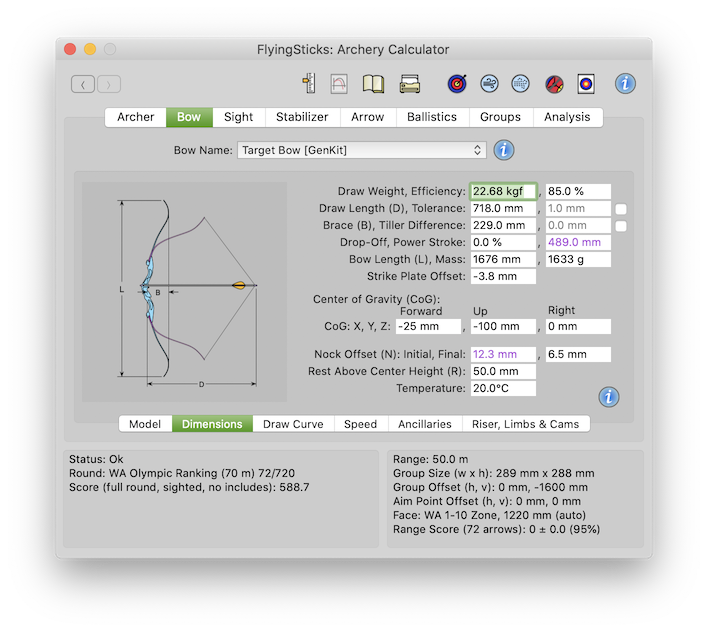
This panel provides for the entry of data for the calculation of bow energy and to assist in tuning. Note that these dimensions need to be your bow's actual values, not those define by the various standards that that have come and gone over the years.

This is the actual peak draw force of the bow. For recurves it is the force at the release point. For compounds it is the peak draw force, typically at about 75% draw.
This field can be auto calculated when the manufacturer's draw data is entered in the Bow>Model panel. If it is available and the check box is checked, then the draw weight will be calculated and loaded here. Changing the draw length (below) will be seen to change the draw weight in response.
This is the notional efficiency of the bow. It is the ratio of the available energy on release (to accelerate the arrow AND the bow's virtual mass) to the draw energy transferred to the bow by the archer's draw. Typical values are in the range 75% to 85% and are independent of arrow mass.
Initially the archer is unlikely to know the efficiency, but it can be measured if the draw curve is know (see Draw Curve panel's Draw Efficiency).
Draw length is the distance between the arrow's nock valley and the bow's pivot point at release. Note that this is not the AMO draw which is 44 mm (1.75") longer.
See "Draw Weight" above when changing this field may also change the draw weight field.

Enter the variability in draw length due to archer's form. It results in variations of launch speed and hence the vertical group size. The impact is dependent on range, launch speed and bow type, particularly the compound bow's drop-off. Compound bows with high drop-off are significantly less sensitive. The checkbox enables or disables the use of the tolerance field, with the same control being available from the Groups panels.
Brace height is the distance between the string and the bow's pivot point for an un-drawn bow.
Comment: the important figure is the power stroke which is the difference between the Draw Length and the Brace height. Frequently the Brace Height receives more attention than it deserves (particularly for compounds) and is used as a means of adjusting the power stroke and hence the available energy.

This field should be set to the top tiller minus the bottom tiller. The check box enables the use of tiller in the internal ballistics calculations. Note: this function is not presently implemented.
For compound bows, the percentage by which the draw forces drops off from peak force to the release position. Typically 40% to 80%, it is usually specified by the manufacturer and is dependent on the cam design but it may change a little with cam tuning.
Simply the draw length minus the brace height. This is the distance over which the archer's draw force loads potential energy into the bow.
The distance between the limb nocks or pulley axles of the bow. When selecting a new bow type, this will default to a value based on the archer's height.
Enter the mass of the bow without with all ancillaries except sight and stabilizers. It is used to analyze stabilizer performance, including bow rotation.
This is the distance from the string center-line to the point where the arrow touches the riser. It defaults to the average of the front and center arrow shaft radius' when the "Set Other Diameters" button is clicked in the Arrow>Shaft panel or when a new center-fire bow type is selected in Bow>Model. If a non-center-fire bow is selected, it defaults to a sensible fixed value.
Bow center of gravity relative to the pivot point with all kit attached except stabilizers. Assumes bow is strung but not drawn. Uses 3D co-ordinate system:
Where forward is positive
Where up is positive
Where right is positive
The bow's CoG moves rearward as the bow is drawn, and is compensated for in the calculator.
This the height from the bow's geometric vertical center (typically the pivot point) to the bottom of an arrow sitting on the rest. For rests with a "V" notch, the precise value will depend on the arrow's diameter, however this level of precision is not required. The height is used to estimate the string nock point prior to tuning.
The nock offset is the position of the lower edge of the top nock along the string from the square (right angle line) from the rest (arrow bottom) to the string in the un-drawn position.
The Initial value is the recommended setting prior to tuning. It is calculated from the Rest Above Center Height, Bow Length, Arrow Diameter and Nock Width.
The Final value is entered after tuning. It is for recording only.
Enter the bow's limb temperature to discover how its performance may change. The modelling of this interaction is basic and derived from limb material properties, not manufacturer's data. Does not include impact of humidity or accumulated condensation or ice.